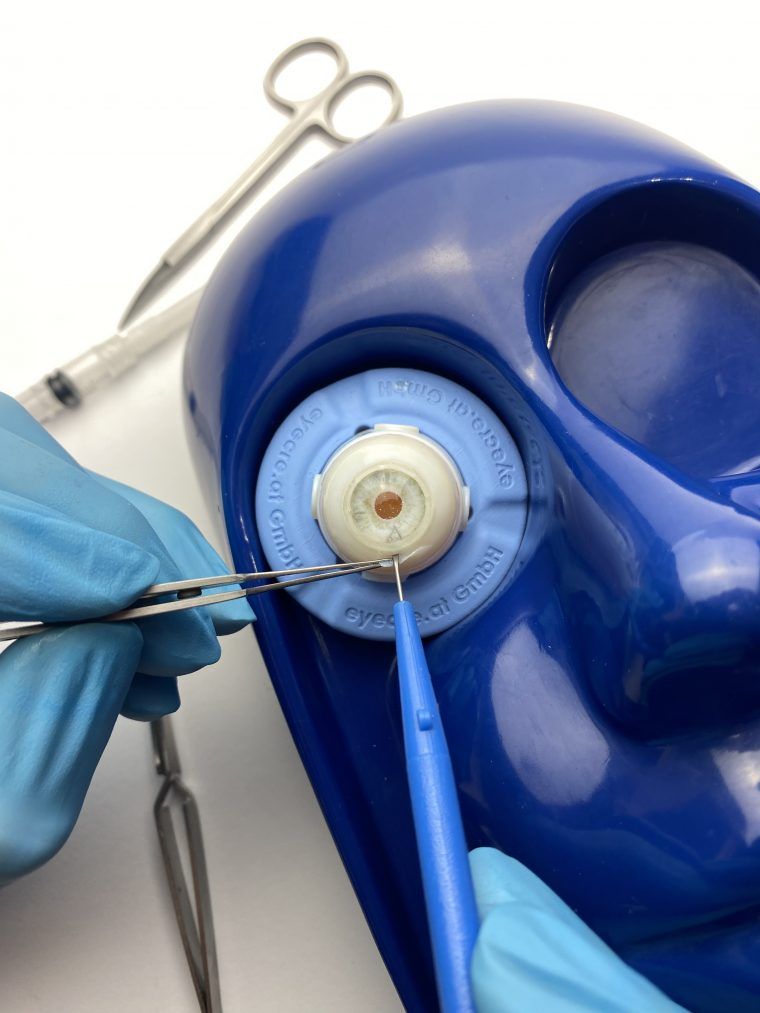Article
Austrian company produces surgical models for ophthalmology
Author(s):
Addion GmbH has selected Stratasys technology to create realistic eye models for ophthalmic surgery.
Addion GmbH is partnering with Stratasys, which will use its J750 Digital Anatomy 3D printer to produce never-before-seen surgical models for ophthalmology.
Austrian-based Addion specializes in customized 3D printed medical model production.
The Stratasys J750 Digital Anatomy 3D printer enables Addion to mimic ultra-soft, watery tissue, and create 3D printed eye models with unprecedented realism. (Images courtesy of Addion)

Using the full color multi-material 3D printer and collaborating closely with medical training solution provider and manufacturer Eyecre.at, Addion is now able to develop and construct artificial eye models with a level of realism that was previously unachievable. This technology provides pharmaceutical companies and providers with true-to-life models that enable improved product testing and surgical training.
The models give ophthalmologists high-quality artificial eye models that mimic the exact anatomy of a human eye including color, haptics and complexity. Addion’s 3D printed eye models allow pharmaceutical companies to develop, advance, and demonstrate medical devices, while medical practitioners can perform surgical training on more standard eye procedures.
By its very nature, the production of 3D eye models is generally a lengthy and complex process. Due to the eye’s watery and ultra-soft tissue, it can be difficult to easily recreate ophthalmologic anatomy using existing medical scanning technology, which means that models are developed from anatomical drawings. The models created using previous 3D printing technologies lacked true-to-life accuracy due to limitations in material options and color capabilities.
According to Alexander Hechenberger, Addion GmbH CEO, the Stratasys J750 Digital Anatomy 3D printer’s innovative materials such as TissueMatrix and GelMatrix, and full color capabilities, now enable Addion’s team to mimic ultra-soft, watery tissue, and create 3D printed models with unprecedented realism.
“The skin layer on the model is a tenth of a millimeter and is detached with very small fine instruments, implanted, and then reattached. This level of detail was previously unimaginable,” he said in a statement.
Hechenberger said the possibilities with the Digital Anatomy Printer are endless.
“Despite the incredible results we have enjoyed to date, we are still just scratching the surface in terms of the technology’s potential,” Hechenberger added in the statement.
Hechenberger noted that there are few comparable alternatives for eye model production in the ophthalmology industry, particularly in the complex recreation of soft tissue with realistic colors and the variety of materials.
“For example, we produced an eye model where the cornea (the white part of the eye) can be detached and reattached,” he said in the statement. “The skin layer on the model is a tenth of a millimeter and is detached with very small fine instruments, implanted, and then reattached. This level of detail was previously unimaginable.”
In addition to the Stratasys 3D printer, Addion is using Stratasys’ GrabCAD print software to optimize the design-to-print workflow.
“Our early experiences using GrabCAD have been wholly positive,” Hechenberger explained. “The software ensures an efficient workflow from data to printing and will hopefully prove invaluable as our experience with the Digital Anatomy Printer grows.”
Looking forward, Addion GmbH is already planning to produce other anatomical models in order to make full use of Stratasys’ unique material offerings like BoneMatrix for simulating bone structures, and TissueMatrix for vascular structures.
“Companies like Addion GmbH perfectly demonstrate the capabilities and potential of the Digital Anatomy Printer,” says Arnaud Toutain, Stratasys’ Healthcare Sales and Development Lead for EMEA. “Through the ultra-realistic eye models that they are developing, we are seeing new possibilities in ophthalmic 3D model precision and complexity. This is representative of a fast-growing 3D printing medical sector, where advanced biomechanical materials that go beyond just aesthetics continue to open up a plethora of new applications within a multitude of disciplines.”
Newsletter
Don’t miss out—get Ophthalmology Times updates on the latest clinical advancements and expert interviews, straight to your inbox.




